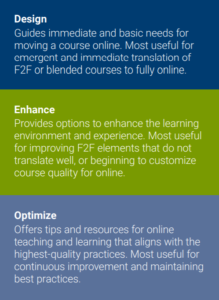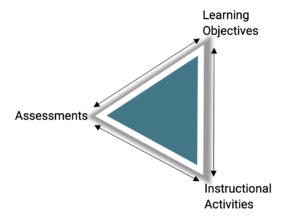Many college and university faculty found themselves suddenly taking their courses online in spring 2020 due to the COVID-19 emergency. Out of necessity, many did that with the resources they could pull together on short notice.
Now they may be searching for resources for improving online courses. To assist that work, Every Learner Everywhere and its partners recently published a comprehensive guide, Optimizing High-Quality Digital Learning Experiences: A Playbook for Faculty.
This resource is designed to guide faculty in thinking and designing strategically to amplify the opportunities the online environment provides in both their digital spaces and physical classrooms. The playbook contains research, inspirational examples, practical guidance, and resource lists on improving online teaching practices that confront equity gaps for minoritized and poverty-affected students.
Embedded in the playbook are references to several dozen resources and practical improvements on equity-centered and accessible design, flexible syllabi, engaging class activities, meaningful assessment, choosing technology, and more.
Here we highlight a selection of the resources recommended by Lynette M. O’Keefe, Ph.D., Director, Research and Innovation at Online Learning Consortium (OLC) and a contributor to the playbook.

Each section of the Faculty Playbook suggests practical ways to Design, Enhance, and Optimize elements of online courses.
“Our resources are built on research and best practices,” she says. “They are primarily geared toward online instruction, but they’re just as applicable to blended learning. Even instructors teaching face to face, or hyflex courses, may find something useful in these. They speak to ways to engage students whether that’s in a classroom or online.”
Resources for course design principles
Apply backward course design: In backward course design, you begin by identifying desired results. ASCD, a professional association for educators, summarizes backward course design in a helpful infographic. A more comprehensive discussion of it is included in the playbook.
Apply basic quality standards: A plan to evaluate the quality of your online courses is essential. OLC offers a free course-level quality rubric that incorporates 50 instructional design and accessibility standards.
Use measurable outcomes: The Eberly Center at Carnegie Mellon University has several resources on course design. This page on designing and teaching a course offers guidance for creating student-centered course design. Their three-point model encourages iteratively improving learning objectives, instructional activities, and assessments.
Apply effective principles: The Carnegie Mellon Eberly Center also provides a useful summary to seven core principles that make teaching more effective.
Use multiple modes of learning: Online courses should use multiple modes of learning to support different learning styles. The ION Professional eLearning Program at University of Illinois Springfield suggests several instructional strategies to build into online courses, such as panels, symposia, projects, and self-directed learning.
Design for all students: Consider web accessibility and usability when designing online courses.
- The University of Arkansas, Little Rock provides a checklist of 10 components of universal design, such as clear site navigation and captioning videos.
- CAST is a nonprofit that created The Universal Design for Learning Guidelines, which provides a framework to improve online teaching and learning.
- A similar set of web content accessibility guidelines comes from the Web Accessibility Initiative.
Design for equity: Peralta College’s Online Equity Rubric is a course evaluation tool to help instructors design more equitable and inclusive online courses.
Resources for teaching practice
Find supplementary tools: Understand your institution’s LMS and augment it with tools that support course outcomes and goals. A good place to browse is the list maintained by Top Tools for Learning of products, apps, and software to integrate with your online learning course.
Set the stage: Introducing yourself to students and setting course expectations establishes instructional continuity. This course orientation module from the Teaching Online Pedagogical Repository at The University of Central Florida will help you get your course started effectively.
Create active learning with interaction: The University of California, Davis guide to Designing and Teaching for Impact in Online Courses discusses ways for students to interact with the instructor, each other, and the course content.
Set clear and explicit expectations: Wiley Publishing’s Center for Teaching and Learning outlines guidance on why you need course expectations and how to communicate them.
Provide academic support: NACADA, a professional organization for academic advising based at Kansas State University, has curated a comprehensive list of academic support resources.
3 essential resources for improving online courses
Asked for the most important concepts a new online instructor should start with, OLC’s O’Keefe recommended these principles:
- Apply basic quality standards like those addressed in the OLC Course Design Review Scorecard.
- Ensure you build in accessibility with universal design in online learning.
- Build in strong interaction between the instructor and student, between students, and with course content.
Next steps
College and university instructors need to be patient and review priorities while improving online courses, advises O’Keefe. If you had to take your course online in a hurry in spring 2020, it couldn’t have been perfect. But now there is an opportunity to access the wealth of existing expertise in online teaching practices.
O’Keefe says, “Really think about what’s most important for students to learn in your course, how you can use what you had already planned, then prioritize what you need to do moving forward.”
Download Optimizing High-Quality Digital Learning Experiences: A Playbook for Faculty
Originally published June 2020. Updated August 2021 with additional information and references.




